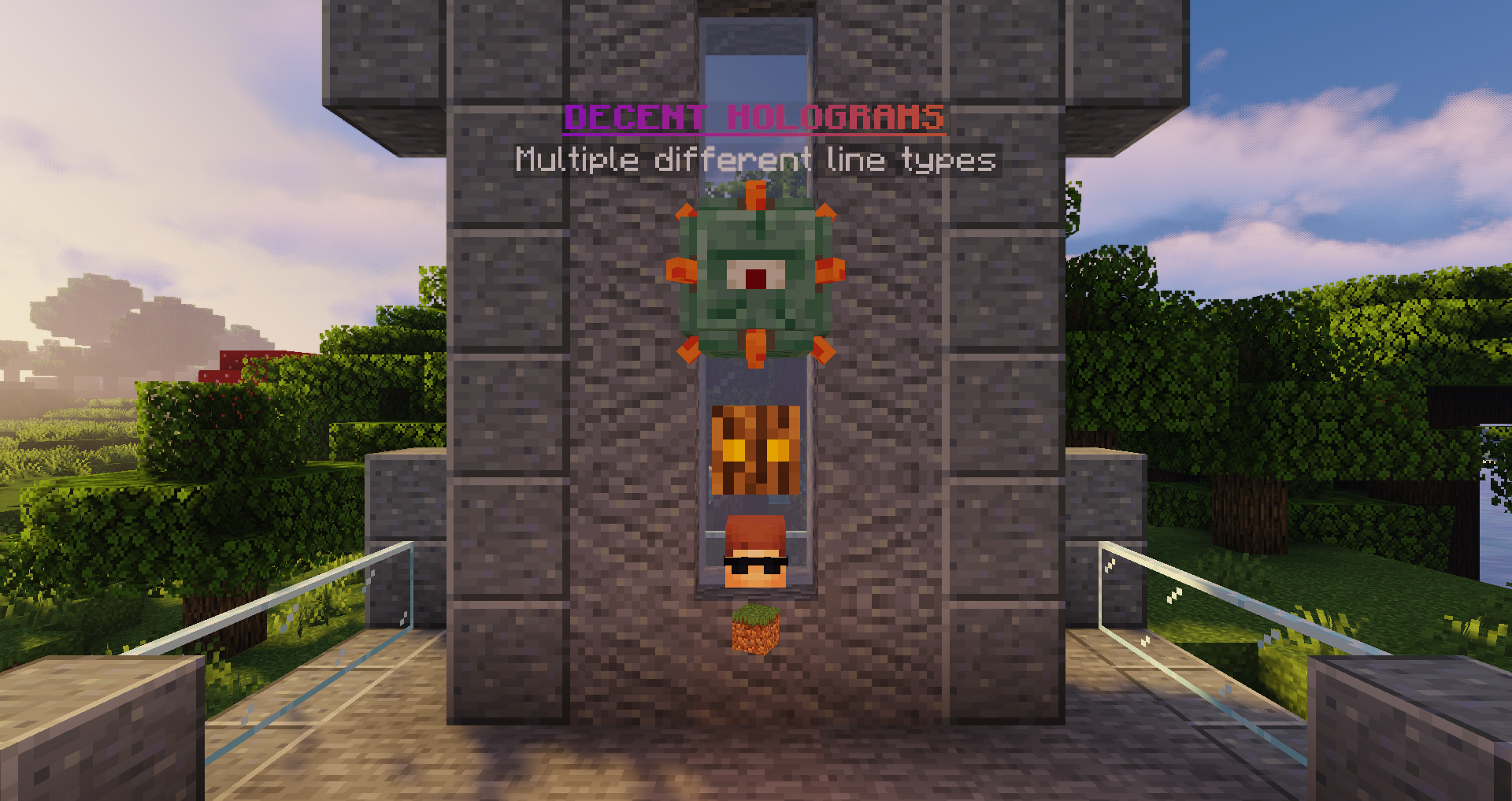Format & Colors
Information about what formats DecentHologram offers
DecentHologram allows to display more than just text. Using a specific pattern, one can display a floating item, item as a head of a (small) armor stand or even entities.
Placeholders
Internal placeholders and placeholders from PlaceholderAPI can be used in text lines but also the other line types.
As an example: Instead of a player name can you use {player} to display the head of who is looking at the hologram.
Text Line¶
This is the default line type used by DecentHolograms. Only when the Line follows a specific pattern (Shown below) will the displayed content not be a floating text.
<text>
&aThis is a normal &f&lText Line&a!
#ICON: <item>¶
Displays a floating item in the Hologram.
Do keep in mind that the item will spin around, which can't be disabled by the plugin. If you want non-moving items, use the #HEAD or #SMALLHEAD Line Type.
#ICON: <item>[:<data>] [options]
[:<data>]only works on versions before 1.13 where<data>is the data value for the item to use. Note that the[]are not required.[options]can be replaced with any of the following options (They can all be used together!):(<value>)where<value>is any of the options listed in the Player Heads section of this page. The()are required!{<nbt>}where<nbt>is any valid NBT data (i.e.CustomModelData:1). The{}are required!
/// Red Wool (Only works on versions before 1.13)
#ICON: WOOL:14
/// Light Blue Leather Chestplate
#ICON: LEATHER_CHESTPLATE {display:{color:3847130}}
/// Player Head of d0by (Use SKULL_ITEM on versions before 1.13)
#ICON: PLAYER_HEAD (d0by)
#HEAD: <item>¶
Displays the item/block as an armor stand's Head gear.
Items displayed this way won't rotate, but may have a visible offset to the Hologram's center.
#HEAD: <item>[:<data>] [options]
[:<data>]only works on versions before 1.13 where<data>is the data value for the item to use. Note that the[]are not required.[options]can be replaced with any of the following options (They can all be used together!):(<value>)where<value>is any of the options listed in the Player Heads section of this page. The()are required!{<nbt>}where<nbt>is any valid NBT data (i.e.CustomModelData:1). The{}are required!
/// Player Head of d0by (Use SKULL_ITEM on versions before 1.13)
#HEAD: PLAYER_HEAD (d0by)
/// Grass Block
#HEAD: GRASS_BLOCK
#SMALLHEAD: <item>¶
Displays the item/block as a small armor stand's Head gear.
Items displayed this way won't rotate, but may have a visible offset to the Hologram's center.
#SMALLHEAD: <item>[:<data>] [options]
[:<data>]only works on versions before 1.13 where<data>is the data value for the item to use. Note that the[]are not required.[options]can be replaced with any of the following options (They can all be used together!):(<value>)where<value>is any of the options listed in the Player Heads section of this page. The()are required!{<nbt>}where<nbt>is any valid NBT data (i.e.CustomModelData:1). The{}are required!
/// Player Head of d0by (Use SKULL_ITEM on versions before 1.13)
#SMALLHEAD: PLAYER_HEAD (d0by)
/// Grass Block
#SMALLHEAD: GRASS_BLOCK
#ENTITY: <entity>¶
Displays an entity. A list of all available entities can be found here.
Notes
- The entity will be displayed in a sitting position, if it has one. This can't be changed.
- Certain Entity types can not be used in the Hologram. A list can be seen here (Last updated: April 27th, 2024).
#ENTITY: <entity>
#ENTITY: PIG
#ENTITY: AXOLOTL
Additional Information¶
Version-specific items/entities¶
You can only use items and entities that actually exist for the Server's Minecraft Version. In addition can the names be different for the same item/entity, if Mojang changed them in-between versions.
As an example, the GRASS item was renamed to SHORT_GRASS in 1.20.4, meaning that on any version before it, you use GRASS while on 1.20.4 and newer you use SHORT_GRASS.
Player Head Textures¶
The following options can be set for the <value> in (<value>):
A valid player name.
Example
Displays the head of the player d0by.
#ICON: PLAYER_HEAD (d0by)
A placeholder that gets turned into a Player name. Internal placeholders and PlaceholderAPI ones work.
Example
Displays the head of the player looking at the hologram.
#ICON: PLAYER_HEAD ({player})
A Base64-encoded texture value can be used. They can often be found on sites such as https://minecraft-heads.com and are usually refered to as value.
Example
Displays the texture of https://minecraft-heads.com/custom-heads/head/1.
#ICON: PLAYER_HEAD (eyJ0ZXh0dXJlcyI6eyJTS0lOIjp7InVybCI6Imh0dHA6Ly90ZXh0dXJlcy5taW5lY3JhZnQubmV0L3RleHR1cmUvOTYzNmRlZTgwNmJhNDdhMmM0MGU5NWI1N2ExMmYzN2RlNmMyZTY3N2YyMTYwMTMyYTA3ZTI0ZWVmZmE2In19fQ==)
HEADDATABASE_<id> can be used where <id> is the number one can find on https://minecraft-heads.com. It can usually be found in the URL.
Example
Displays the texture of https://minecraft-heads.com/custom-heads/head/1 using the HeadDatabase Plugin.
#ICON: PLAYER_HEAD (HEADDATABASE_1)
